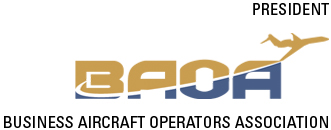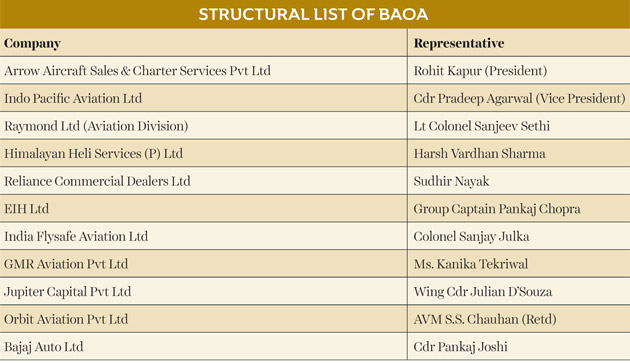‘Big Bang Reforms to Facilitate Business and General Aviation Growth’
BAOA 2.0
 |  |
As I take over the role of President of Business Aircraft Operator Association (BAOA) for the third time, I would like to thank all members of BAOA for reposing their faith in me, the new Governing Board (GB) and the BAOA team. I am mindful of the fact that this places a tremendous responsibility on the all of us to deliver on the promises for which the Association was formed in 2011. Currently in its seventh year, BAOA has much to be proud of. It has been the voice of the industry since it was established and has gained a credibility, both with the stake holders, and the regulatory authorities. For the first time, the entire business aviation community came together to create an environment for the upliftment of our industry. We have had several successes in the past, be it on operational matters, regulatory issues or B&GA infrastructure growth in the industry. Our role in the international business aviation community was recognised when one of our GB members was elected as the Treasurer of International Business Aviation Council (IBAC) board, for the first time in history.
However, when I ask myself the question if we are in a better state than we were seven years ago, I‘m not too sure if I can give a positive response confidently. For every step taken forward, there has been a new rule that makes life difficult for all owners, operators and service providers of the industry. Aircraft ownership is still a painful process, with delays in CAP 3100 process, DGCA rules that sometimes defy logic, lack of infrastructure, high rates of taxations and illogical import duties. Mumbai airport remains out of bounds for business aviation, with tough curfew timings, lack of parking slots, and astronomical penal charges. Obtaining slots in Mumbai at short notice is a nightmare for most operators. It is unfortunate that the financial capital of the country which has 50 per cent of the B&GA aircraft users in India, still denies the basic infrastructure, and operational flexibility, that is available to most business leaders in the world to drive the economic engine of the nation. With Navi Mumbai still some years ago, and Juhu having its own issues, the path ahead seems bleak. It is ironical that there has been no additional parking slot given to any B&GA aircraft in Mumbai for the past 10 years!
The Omdas, and other agreements of the past, have made a historical blunder by not planning for the growth of B&GA in India, and the airport operators have not been directed to do so. However, blunders can be corrected, if there is a will to resolve it. We have seen this in the past, and hope the same will happen in the future.
But it‘s not only about Mumbai. The problems lie in the fact that business aviation infrastructure planning has never been done in India, hence the airports were never designed for the operations of B&GA aircraft. The OMDAs, and other agreements of the past, have made a historical blunder by not planning for the growth of B&GA in India, and the airport operators have not been directed to do so. However, blunders can be corrected, if there is a will to resolve it. We have seen this in the past, and hope the same will happen in the future. We are confident that the under able leadership of the Hon‘ble Prime Minister, and the progressive team of the Hon‘ble Minister of Civil Aviation, MOS, the Secretary Civil Aviation, this problem will be addressed sooner, rather than later. We need reforms in rules and regulations, collaborative rule making, e-governance in DGCA, infrastructure planning for B&GA, and rationalising of taxes and duties. The government has shown, with the RCS scheme, that it can successfully implement new schemes, when it is motivated to do so. We do hope that growth for B&GA will be the next focus of this government.
While we ask the Government to do its bit, our own house needs cleaning too. The industry is fragmented and crying out for consolidation. We still have a number of operators who are not averse to taking “short cuts”, in the name of commercial interest. Safety is paramount, and at BAOA we are fully supportive of the Safety Regulators to implement their safety programmes with no compromise on safety. With this in mind, BAOA has started conducting Safety Workshops for all aircraft operators this year, with the first one being held in Delhi in Feb 2017. We plan to organise two more of these workshops this year, one in Mumbai, and the other in Bengaluru. As in the case of the Delhi Workshop, we solicit the support of the DGCA for future ones too. Besides this, BAOA itself needs to prepare itself for the future. Our Bye Laws, formed in 2011, seem dated now, and not adequately inclusive of all members. We will ensure that a BAOA Committee will review the Bye Laws, and make requisite amendments as required. BAOA needs to tighten internal governance processes, and needs to be focused on delivering time bound results, to the expectations of our members. Going forward, we will set systems in place to make sure that these expectations are met. Every organisation is dynamic, and needs to evolve with time and circumstances. At BAOA, we recognise this, and will do all that is required to keep our organisation progressive.
The BAOA industry report released in 2016 was a stellar effort by the association to map out the industry, and what potential it offers. It also spelt out the issues that face the industry, due to which the growth has retarded to distressing numbers over the past few years. The helicopter and MRO industry continues to perform below par, with no major growth shown in the past five years or so. The primary aim of BAOA is to work with all stake holders, be it aircraft operators/owners, airport operators, AAI, DGCA, MOCA, AERA and BCAS, to create an environment for the growth of this industry. We are confident that all the stakeholders have a similar aim, though priorities may vary. It is our job to align all the stake holders on a common platform so that we can exploit the true potential of this industry. The challenge for us is whether we can excite and motivate the government to plan for the “Big Bang” reforms to facilitate business and general aviation growth, as they did for the Regional Connectivity Scheme!
I assure you that BAOA 2.0 will endeavour to be more transparent, responsive and collaborative for everyone. I seek the cooperation of all industry stakeholders and members for the same.
Rohit Kapur
President, Business Aircraft Operators Association






